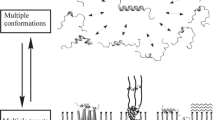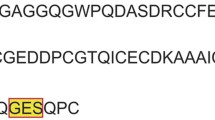Abstract
Cytotoxins are positively charged polypeptides that constitute about 60% of all proteins in cobra venom; they have a wide spectrum of biological activities. By CD spectroscopy, cytotoxins CT1 and CT2 Naja oxiana, CT3 Naja kaouthia, and CT1 and CT2 Naja haje were shown to have similar secondary structure in an aqueous environment, with dominating β-sheet structure, and to vary in the twisting angle of the β-sheet and the conformation of disulfide groups. Using dodecylphosphocholine micelles and liposomes, CT1 and CT2 Naja oxiana were shown to incorporate into lipid structures without changes in the secondary structure of the peptides. The binding of CT1 and CT2 Naja oxiana with liposomes was associated with an increase in the β-sheet twisting and a sign change of the dihedral angle of one disulfide group. The cytotoxins were considerably different in cytotoxicity and cooperativity of the effect on human promyelocytic leukemia cells HL60, mouse myelomonocytic cells WEHI-3, and human erythroleukemic cells K562. The most toxic CT2 Naja oxiana and CT3 Naja kaouthia possessed low cooperativity of interaction (Hill coefficient h = 0.6-0.8), unlike 10-20-fold less toxic CT1 and CT2 Naja haje (h = 1.2-1.7). CT1 Naja oxiana has an intermediate position on the cytotoxicity scale and is characterized by h = 0.5-0.8. The cytotoxins under study induced necrosis of HL60 cells and failed to activate apoptosis. The differences in cytotoxicity are supposed to be related not with features of the secondary structure of the peptides, but with interactions of side chains of variable amino acid residues with lipids and/or membrane proteins.
Similar content being viewed by others
REFERENCES
Kini, R.M. (2002) Clin. Exp. Pharmacol. Physiol.,29, 815–822.
Dufton, M.J., and Hider, R.C. (1988) Pharmacol. Ther., 36, 1–40.
Dufton, M.J., and Hider, R.C. (1991) in Snake Toxins(Harvey, A.L.,ed.) Pergamon Press Inc., New York,pp. 259–302.
Wu, W., Li, Y., and Szabo, G. (1993) FASEB J.,7, A1235.
Rees, B., and Bilwes, A. (1993) Chem. Res. Toxicol.,6, 385–406.
Chien, K.-Y., Chiang, C.-M., Hseu, Y.-C., Vyas, A.A., Rule, G.S., and Wu, W.-G. (1994) J. Biol. Chem.,269, 14473–14483.
Bilwes, A., Rees, B., Moras, D., Menez, R., and Menez, A. (1994) J. Mol. Biol.,239, 122–136.
Harvey, A.L. (1991) in Handbook of Natural Toxins(Tu, A.T.,ed.)Vol.5,Marcel Dekker,Inc., New York,pp.85–106.
Fletcher, J.E., and Jiang, M.-S. (1993) Toxicon, 31, 669–695.
Jayaraman, G., Kumar, T.K., Tsai, C.C., Srisailam, S., Chou, S.H., Ho, C.L., and Yu, C. (2000) Protein Sci.,9, 637–646.
Su, S.H., Su, S.J., Lin, S.R., and Chang, K.L. (2003) Toxicol. Appl. Pharmacol.,193, 97–105.
Kuo, J.F., Raynor, R.L., Mazzei, G.J., Schatzman, R.C., Turner, R.S., and Kem, W.R. (1983) FEBS Lett.,153, 183–186.
Chiou, S.H., Raynor, R.L., Zheng, B., Chambers, T.C., and Kuo, J.F. (1993) Biochemistry, 32, 2062–2067.
Chiou, S.H., Hung, C.C., Huang, H.C., Chen, S.T., Wang, K.T., and Yang, C.C. (1995) Biochem. Biophys. Res. Commun.,206, 22–32.
Harvey, A.L. (1985) J.Toxicol. Toxin. Rev.,4, 41–69.
Lin, S.R., Chang, L.S., and Chang, K.L. (2002) J. Protein Chem.,21, 81–86.
Abu-Sinna, G., Esmat, A.Y., Al-Zahaby, A.A., Soliman, N.A., and Ibrahim, T.M. (2003) Toxicon, 42, 207–215.
Iwaguchi, T., Takechi, M., and Hayashi, K. (1985) Biochem. Int.,10, 343–349.
Stevens-Truss, R., Messer, W.S., and Hinman, C.L. (1996) J.Membr. Biol.,150, 113–122.
Hinman, C.L., Jiang, X.L., and Tang, H.P. (1990) Toxicol. Appl. Pharmacol.,104, 290–300.
Kahn, P.C. (1979) Meth. Enzymol.,61, 339–378.
Dementieva, D.V., Utkin, Y.N., and Arseniev, A.S. (1996) Bioorg. Khim.,22, 339–352.
Dementieva, D.V., Bocharov, E.V., and Arseniev, A.S. (1999) Eur. J. Biochem.,263, 152–162.
Dubovskii, P.V., Dementieva, D.V., Bocharov, E.V., Utkin, Y.N., and Arseniev, A.S. (2001) J. Mol. Biol.,305, 137–149.
Grishin, E.V., Sukhikh, A.P., Adamovich, T.B., and Ovchinnikov, Yu.A. (1976) Bioorg. Khim.,2, 1018–1034.
Dubinnyi, M.A., Dubovskii, P.V., Utkin, Y.N., Simonova, T.N., Barsukov, L.I., and Arseniev, A.S. (2001) Bioorg. Khim.,27, 102–113.
Feofanov, A., Grichine, A., Karmakova, T., Pljutinskaya, A., Lebedeva, V., Filyasova, A., Yakubovskaya, R., Mironov, A., Egret-Charlier, M., and Vigny, P. (2002) Photochem. Photobiol.,75, 633–643.
Grognet, J.M., Menez, A., Drake, A., Hayashi, K., Morrison, I.E., and Hider, R.C. (1988) Eur. J. Biochem., 172, 383–388.
Hider, R.C., Drake, A.F., and Tamiya, N. (1988) Biopolymers, 27, 113–122.
Illangasekare, M.P., and Woody, R.W. (1986) Biophys. J., 49, 296a.
Golovanov, A.P., Efremov, R.G., Jaravine, V.A., Vergoten, G., and Arseniev, A.S. (1995) FEBS Lett.,375, 162–166.
Forouhar, F., Huang, W.N., Liu, J.H., Chien, K.Y., Wu, W.G., and Hsiao, C.D. (2003) J. Biol. Chem.,278, 21980–21988.
Chou, K.-C., Pottle, M., Nemethy, G., Ueda, Y., and Sheraga, H.A. (1982) J. Mol. Biol.,162, 89–112.
Herrmann, T., Guntert, P., and Wuthrich, K. (2002) J. Mol. Biol.,319, 209–227.
Author information
Authors and Affiliations
Rights and permissions
About this article
Cite this article
Feofanov, A.V., Sharonov, G.V., Dubinnyi, M.A. et al. Comparative Study of Structure and Activity of Cytotoxins from Venom of the Cobras Naja oxiana, Naja kaouthia, and Naja haje . Biochemistry (Moscow) 69, 1148–1157 (2004). https://doi.org/10.1023/B:BIRY.0000046890.46901.7e
Issue Date:
DOI: https://doi.org/10.1023/B:BIRY.0000046890.46901.7e




